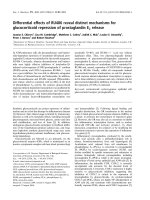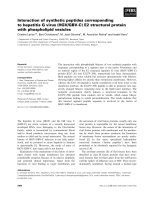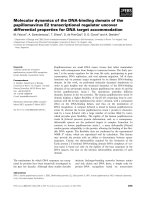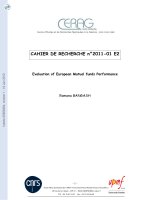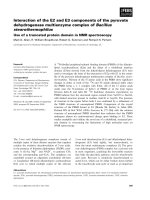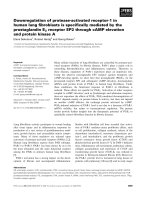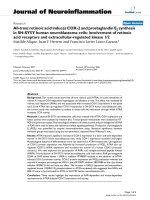cima e2 enterprisemanagement
Bạn đang xem bản rút gọn của tài liệu. Xem và tải ngay bản đầy đủ của tài liệu tại đây (1.99 MB, 555 trang )
CIMA Official
Learning System
Managerial Level
E2 — Enterprise
Management
Ann Norton
Jenny Hughes
CIMA Publishing is an imprint of Elsevier
Linacre House, Jordan Hill, Oxford OX2 8DP, UK
30 Corporate Drive, Suite 400, Burlington, MA 01803, USA
Copyright © 2009 Elsevier Ltd. All rights reserved
No part of this publication may be reproduced, stored in a retrieval system
or transmitted in any form or by any means electronic, mechanical, photocopying,
recording or otherwise without the prior written permission of the publisher
Permissions may be sought directly from Elsevier’s Science & Technology Rights
Department in Oxford, UK: phone ( ϩ 44) (0) 1865 843830; fax ( ϩ 44) (0) 1865 853333;
email: Alternatively you can visit the Science and Technology
Books website at www.elsevierdirect.com/right for further information.
Notice
No responsibility is assumed by the publisher for any injury and/or damage to persons
or property as a matter of product’s liability, negligence or otherwise, or from any use
or operation of any methods, products, instructions or ideas contained in the material
herein.
British Library Cataloguing in Publication Data
A catalogue record for this book is available from the British Library
Library of Congress Cataloguing in Publication Data
A catalogue record for this book is available from the Library of Congress
978-1-85617-788-7
For information on all CIMA publications
visit our website at www.elsevierdirect.com
Typeset by Macmillan Publishing Solutions
( www.macmillansolutions.com)
Printed and bound in Hungary
09 10 11 11 10 9 8 7 6 5 4 3 2 1
Working together to grow
libraries in developing countries
www.elsevier.com | www.bookaid.org | www.sabre.org
iii
Contents
The CIMA Learning System xiii
Acknowledgements xiii
How to use your CIMA Learning System xiii
Guide to the Icons used within this Text xiv
Study technique xv
Paper E2 — Enterprise Management xvii
1 The Nature of Strategic Management 1
Learning Outcomes 3
1.1 Introduction to the nature of strategic management 3
1.2 The concept of strategy 3
1.2.1 Common themes in strategy 4
1.3 Levels of strategy 4
1.4 A model of the rational strategy process 6
1.4.1 Mission, objectives and goals 7
1.4.2 The link between mission, goals and objectives 8
1.4.3 The goal structure 9
1.4.4 External environmental and competitive analysis 10
1.4.5 Internal analysis/position audit 12
1.4.6 Corporate appraisal (SWOT) 13
1.4.7 Strategic options and choice 14
1.4.8 Strategy implementation 16
1.4.9 Review and control 16
1.5 Criticisms of the rational model of strategy formulation 16
1.6 A formal top-down strategy process 18
1.6.1 Benefi ts of the formal top-down approach to strategy 19
1.6.2 Drawbacks of the formal top-down approach to strategy 20
1.7 Strategy and small businesses 21
1.8 Achieving competitive advantage – alternative perspectives:
resource-based view versus the positioning view 23
1.8.1 Competitive advantage and economic theory 23
1.8.2 The positioning approach 23
1.8.3 Resource-based view 24
1.8.4 Principles of resource-based theory 24
1.8.5 The implications of the resource-based view for strategy
development 27
1.9 Alternative approaches to formulating strategy 28
1.9.1 Emergent strategies 28
1.9.2 Logical incrementalism 29
ENTERPRISE MANAGEMENT E2
iv
CONTENTS
1.10 Stakeholders 31
1.10.1 The infl uence of stakeholders 32
1.10.2 The Mendelow matrix 32
1.10.3 Assessing power of stakeholders 33
1.10.4 Assessing interest of stakeholders 33
1.10.5 Strategies to deal with stakeholders 34
1.10.6 Confl ict between stakeholders 35
1.11 Meeting the objectives of shareholders 35
1.11.1 Maximisation of shareholder wealth as an objective 36
1.11.2 Competing objectives 36
1.11.3 Resolving competing objectives 37
1.12 Summary 38
Section A type questions 55
Section B type questions 56
Section A solutions 59
Section B solutions 61
2 The Nature of the Competitive Environment 67
Learning Outcomes 69
2.1 Introduction 69
2.2 Environmental impact assessment 69
2.3 Different stages in environmental analysis 70
2.3.1 Analysing the macro-environment 71
2.3.2 Analysing the micro-environment/industry environment 73
2.3.3 Industry life cycle analysis 78
2.3.4 Illustration of external environmental analysis – Example
of a car manufacturer 78
2.3.5 Evaluation of environmental models 80
2.3.6 Survival and success factors 81
2.4 Causes of environmental uncertainty 81
2.4.1 Impact of uncertainty 82
2.4.2 Has uncertainty really increased? 83
2.5 Competitor analysis 83
2.5.1 The importance of competitor analysis 83
2.5.2 Competitor analysis – key concepts 84
2.5.3 Levels of competitors 84
2.5.4 Gathering competitor intelligence 86
2.5.5 Forecasting competitors’ response profi les 88
2.6 Competitor accounting 89
2.6.1 Evaluation of barriers to entry 89
2.6.2 Estimate competitors’ costs 90
2.7 The global economic environment 90
2.7.1 The new global economy 91
2.8 National competitive advantages 93
2.8.1 Porter’s Diamond 93
2.8.2 Demand conditions 93
v
ENTERPRISE MANAGEMENT
CONTENTS
2.8.3 Related and supporting industries 94
2.8.4 Factor conditions 94
2.8.5 Firm structure, strategy and rivalry 94
2.8.6 Other events 94
2.8.7 National competitive advantage 94
2.8.8 Losing competitive advantage 95
2.8.9 Porter’s strategic prescriptions 95
2.8.10 Comment on Porter’s Diamond 95
2.9 Country analysis and political risk 96
2.9.1 Political risk 96
2.10 Sources of information for environmental analysis 97
2.10.1 Environmental scanning 97
2.10.2 Accessing environmental information 98
2.10.3 Detailed environmental analysis 98
2.10.4 Categorisation of information sources 99
2.11 Summary 99
Section A type question 101
Section B type questions 101
Section A solutions 103
Section B solutions 104
3 Contemporary Perspectives in Strategy
Development
109
Learning Outcome 111
3.1 Introduction 111
3.2 Internationalisation and globalisation 112
3.3 Complex organisation forms 114
3.3.1 Strategic alliances 115
3.3.2 Illustrations of network organisations 115
3.4 Theoretical basis of network organisations – transactions cost theory 117
3.4.1 Assest specifi city – an illustration 118
3.4.2 A critique of transactions cost theory 120
3.5 Social responsibility and strategic decisions 122
3.5.1 Must social responsibility confl ict with benefi ting
shareholders? 122
3.5.2 An ecological perspective and environmental
responsibilities 124
3.5.3 Shareholder wealth and ethics 125
3.5.4 Implications of ethics for the chartered management
accountant 127
3.6 Summary 128
Section A type questions 135
Section B type questions 136
Section A solutions 139
Section B solutions 142
ENTERPRISE MANAGEMENT E2
vi
CONTENTS
4 Understanding Project Management 149
Learning Outcomes 151
4.1 Introduction 151
4.2 Projects and project management – defi nitions 152
4.3 Characteristics of a project 152
4.4 The project life cycle 153
4.4.1 The project life-cycle phases 153
4.4.2 An alternative project life cycle – an iterative process 155
4.4.3 Project approaches 155
4.4.4 Other project management frameworks: 4, 5, 7 or 9? 156
4.5 The project as a conversion process 158
4.5.1 Inputs 158
4.5.2 Constraints 158
4.5.3 Outputs 159
4.5.4 Mechanisms 159
4.6 Strategy and scope 159
4.7 Projects and the project manager 159
4.7.1 The roles of the project manager 160
4.7.2 The responsibilities of the project manager 160
4.7.3 Organisation 160
4.7.4 The project manager and project planning 161
4.7.5 The project manager and controlling 161
4.8 The skills of the project manager 162
4.8.1 Leadership skills 162
4.8.2 Communication skills 163
4.8.3 Negotiation skills 163
4.8.4 Delegation skills 165
4.8.5 Problem-solving skills 165
4.8.6 Change-management skills 165
4.9 Projects and people – project teams 166
4.9.1 Problems of project team-working 166
4.9.2 Unclear team goals and objectives 166
4.9.3 Lack of team structure 167
4.9.4 Lack of defi nition of roles 167
4.9.5 Poor leadership 167
4.9.6 Poor team communication 167
4.9.7 Lack of commitment 168
4.9.8 Project management and team-building 168
4.9.9 Project team meetings 168
4.10 Project stakeholders 169
4.10.1 Managing stakeholder expectations 170
4.10.2 Stakeholder confl ict 171
4.11 Projects and organisation structures and support 171
4.11.1 Matrix organisations 171
4.11.2 Project offi ce 173
4.12 Why some projects fail 173
vii
ENTERPRISE MANAGEMENT
CONTENTS
4.13 Examples of projects 174
4.13.1 One successful project – ongoing 175
4.13.2 One not so successful project 177
4.14 Summary 179
Section A type questions 199
Section B type questions 200
Section A solutions 203
Section B solutions 205
5 The Process of Project Management 209
Learning Outcomes 211
5.1 Introduction 211
5.2 The project management process 212
5.3 Project initiation 212
5.3.1 Setting project objectives 212
5.3.2 Identifying project proposals 212
5.3.3 Formation of project proposals 213
5.3.4 Setting project requirements 213
5.3.5 Assessing project feasibility 214
5.3.6 Risk and uncertainty 218
5.3.7 Uncertainty 219
5.3.8 SWOT analysis 219
5.3.9 The project Initiation Document 221
5.4 Project planning 222
5.4.1 Detailed project planning 223
5.4.2 Project objective constraints 226
5.5 Tools and techniques to aid project planning 227
5.5.1 Work breakdown structure 227
5.5.2 Gantt charts 227
5.5.3 Network analysis 228
5.5.4 Slack or fl oat 231
5.5.5 An alternative method for constructing network diagrams:
activity on node 231
5.5.6 Milestones and control gates 232
5.5.7 Project evaluation and review technique (PERT) 233
5.5.8 Coping with risk and uncertainty 233
5.6 Project management (PM) software 234
5.6.1 PM software functions 234
5.6.2 Advantages of using PM software 235
5.6.3 PM software pitfalls 235
5.7 Executing or performing the project 236
5.8 Monitoring and controlling the project 237
5.8.1 Making effective control decisions 238
5.8.2 Earned value management 239
5.8.3 PRINCE2 methodology 240
5.8.4 Other project management methodologies 241
ENTERPRISE MANAGEMENT E2
viii
CONTENTS
5.9 Project completion and closure 242
5.9.1 Organising project documentation 242
5.9.2 Collection of receipts and making fi nal payments 242
5.10 Post-completion review and audit 243
5.10.1 Post-project review meetings 243
5.10.2 Post-completion audit 243
5.10.3 Justifying the cost of post-completion audit 243
5.10.4 Continuous improvement 244
5.11 Summary 245
Section A type questions 265
Section B type questions 268
Section A solutions 273
Section B solutions 280
6 Management 289
Learning Outcomes 291
6.1 Introduction 291
6.2 Classical and contemporary theories of management 291
6.2.1 The Classical School 292
6.2.2 The human relations school 296
6.2.3 Systems theory 297
6.2.4 Contingency theory 298
6.2.5 Peter Drucker: management by objectives (MBO) 300
6.2.6 Contemporary perspectives on organisations 301
6.3 Power, authority, responsibility and delegation 302
6.3.1 Power and authority 302
6.3.2 Authority as legitimate power 302
6.3.3 Organisational power 303
6.3.4 Responsibility 304
6.3.5 Delegation 305
6.4 Management and the Role of Managers 306
6.4.1 Managers or Leaders 307
6.5 Different Perspectives of Leadership 308
6.5.1 Personality, trait or qualities theories of leadership 308
6.5.2 Management styles 309
6.5.3 One best style? 314
6.6 Contingency and Situational theories of leadership 314
6.6.1 John Adair action-centred leadership 315
6.6.2 Fiedler 315
6.6.3 Hersey and Blanchard 316
6.7 Transformational leaders 316
6.8 Entrepreneurs 317
6.9 Organisational culture 318
6.9.1 Different levels of culture 320
6.9.2 Models for categorising culture 321
6.9.3 Culture and organisational effectiveness 323
ix
ENTERPRISE MANAGEMENT
CONTENTS
6.9.4 Culture – The International Dimension 326
6.9.5 Culture and control 326
6.10 Managing in different cultures 327
6.10.1 National cultures 327
6.10.2 Other cultural characteristics 328
6.10.3 Changing behaviour 328
6.11 Mentoring 329
6.12 Summary 330
Section A type questions 331
Section B type questions 332
Section A solutions 335
Section B solutions 337
7 Management of Relationships in the Working
Environment
343
Learning Outcomes 345
7.1 Introduction 345
7.2 The meaning of groups and teams 345
7.3 Types of groups 346
7.3.1 Formal groups 346
7.3.2 Informal groups 346
7.3.3 Reference groups 347
7.3.4 Self directed and autonomous groups 347
7.4 Effective group performance 347
7.4.1 Formation and development 348
7.4.2 Group cohesiveness 348
7.4.3 Team roles 349
7.5 Group dynamics and team performance 350
7.5.1 High-performance teams 351
7.6 Problems with groups 351
7.7 Communication 353
7.7.1 Oral and written communication 353
7.7.2 The communication process 354
7.8 Effective meetings 356
7.8.1 The roles of team members in meetings 357
7.8.2 Problems with meetings 358
7.9 Negotiation 359
7.9.1 The aim of negotiation 359
7.9.2 Phases involved in negotiation 359
7.9.3 Negotiation approaches 360
7.10 Management of the fi nance function 360
7.10.1 Business Process Outsourcing (BPO) 360
7.10.2 Outsourcing non-core activities 361
7.10.3 Benefi ts of outsourcing 361
7.10.4 Drawbacks of outsourcing 361
7.10.5 Shared service centres (SSC) 362
7.10.6 Benefi ts of shared services 362
ENTERPRISE MANAGEMENT E2
x
CONTENTS
7.10.7 Embedding fi nance personnel in business and strategic
decision processes 363
7.10.8 Contribution of fi nance to other functions 363
7.11 The fi nance function and external stakeholders 363
7.11.1 External reporting 364
7.12 Summary 365
Section A type questions 367
Section B type questions 368
Section A solutions 371
Section B solutions 374
8 Control Systems in Organisations 381
Learning Outcomes 383
8.1 Introduction 383
8.2 The meaning of control 383
8.3 A review of management theorists and control 384
8.4 Basic control models 385
8.5 Types of organisational control 386
8.5.1 Personal centralised control 386
8.5.2 Bureaucratic control 386
8.5.3 Output control 386
8.5.4 Clan or cultural control 387
8.6 Objectives of internal control systems 387
8.7 Internal control systems 387
8.8 Levels of control 388
8.8.1 Strategic control 389
8.8.2 Tactical control 389
8.8.3 Operational control 390
8.9 Effective control systems 390
8.10 Practical diffi culties with control systems 390
8.11 An example of a control system in practice: HR and staff
performance appraisal 391
8.11.1 Strategic level 391
8.11.2 Tactical level – performance appraisal and the
employment contract 391
8.12 Health and safety 393
8.12.1 Safety committee and representatives 394
8.12.2 Managing safety 394
8.12.3 Working with contractors 394
8.12.4 Health and safety training 395
8.13 The nature of business ethics 396
8.13.1 Factors affecting ethical obligations 397
8.13.2 Developing an ethical organisation 398
8.13.3 Example of an ethical issue 399
xi
ENTERPRISE MANAGEMENT
CONTENTS
8.14 Professional ethics 400
8.14.1 Fundamental principles 400
8.14.2 Conceptual framework 401
8.15 Corporate governance 401
8.15.1 What is corporate governance 401
8.15.2 The earliest considerations of corporate governance 402
8.15.3 The combined code principles of corporate governance 404
8.15.4 The benefi ts of corporate governance 405
8.16 Summary 406
Section A type questions 407
Section B type questions 408
Section A solutions 411
Section B solutions 414
9 Confl ict and Discipline 421
Learning Outcomes 423
9.1 Introduction 423
9.2 The nature of confl ict in organizations 423
9.2.1 The symptoms of confl ict 424
9.2.2 Horizontal confl ict 424
9.2.3 Vertical confl ict 427
9.2.4 Handling confl ict 427
9.2.5 Managing intergroup confl ict 429
9.2.6 Industrial relations and confl ict 431
9.2.7 Resolutions of industrial relations confl ict 432
9.3 Discipline 434
9.3.1 The meaning of discipline 434
9.3.2 Self-discipline 435
9.3.3 Disciplinary situations 435
9.3.4 Taking disciplinary action 435
9.3.5 Immediacy: Douglas McGregor’s ‘hot stove rule’ 437
9.3.6 Disciplinary procedures 437
9.3.7 ACAS code of practice 439
9.4 Grievance procedures 439
9.5. Tribunal applications 440
9.5.1 Resolving disputes without a tribunal hearing 441
9.6 Dismissal, redundancy and job insecurity 441
9.7 Fairness and commitment in the work place 442
9.7.1 Diversity and equal opportunities 446
9.7.2 Working time directives 448
9.7.3 Child care 448
9.8 Summary 449
Section A type questions 451
Section B type questions 453
ENTERPRISE MANAGEMENT E2
xii
CONTENTS
Section A solutions 457
Section B solutions 460
Preparing for the Examination 465
Revision technique 467
Getting down to work 468
Tips for the fi nal revision phase 468
Format of the examination 469
Section A type questions 469
Section B type questions 472
Background 475
The World Youth Indoor Games, November 2004 475
Project sponsor 475
Farchester Games Co-ordination Committee (FGCC) 475
Defi nition and objectives of the project 476
Telecommunications and Information Technology 476
Software requirements 476
Project activities 476
Critical project dimensions 477
Project status 478
Section A solutions 481
Section B solutions 490
Exam Q & As 513
Index 515
xiii
The CIMA
Learning System
Acknowledgements
Every effort has been made to contact the holders of copyright material, but if any here
have been inadvertently overlooked the publishers will be pleased to make the necessary
arrangements at the fi rst opportunity.
How to use your CIMA Learning System
This Enterprise Management Learning System has been devised as a resource for students
attempting to pass their CIMA exams, and provides:
●
a detailed explanation of all syllabus areas;
●
extensive ‘practical’ materials, including readings from relevant journals;
●
generous question practice, together with full solutions;
●
an exam preparation section, complete with exam standard questions and solutions.
This Learning System has been designed with the needs of home-study and distance-
learning candidates in mind. Such students require very full coverage of the syllabus topics,
and also the facility to undertake extensive question practice. However, the Learning
System is also ideal for fully taught courses.
The main body of the text is divided into a number of chapters, each of which is organ-
ised on the following pattern:
●
Detailed learning outcomes expected after your studies of the chapter are complete. You
should assimilate these before beginning detailed work on the chapter, so that you can
appreciate where your studies are leading.
●
Step-by-step topic coverage. This is the heart of each chapter, containing detailed explana-
tory text supported, where appropriate, by worked out examples and exercises. You
should work carefully through this section, ensuring that you understand the material
being explained and can tackle the examples and exercises successfully. Remember that
in many cases knowledge is cumulative: if you fail to digest earlier material thoroughly,
you may struggle to understand later chapters.
●
Readings and activities. Most chapters are illustrated by more practical elements, such
as relevant journal articles or other readings, together with comments and questions
designed to stimulate discussion.
ENTERPRISE MANAGEMENT E2
xiv
●
Question practice. The test of how well you have learned the material is your ability to
tackle exam-standard questions. Make a serious attempt at producing your own answers,
but at this stage do not be too concerned about attempting the questions in exam condi-
tions. In particular, it is more important to absorb the material thoroughly by complet-
ing a full solution than to observe the time limits that would apply in the actual exam.
●
Solutions. Avoid the temptation merely to ‘audit’ the solutions provided. It is an illusion
to think that this provides the same benefi ts as you would gain from a serious attempt of
your own. However, if you are struggling to get started on a question, you should read
the introductory guidance provided at the beginning of the solution, and then make
your own attempt before referring back to the full solution.
Having worked through the chapters, you are ready to begin your fi nal preparations for
the examination. The fi nal section of this CIMA Learning System provides you with the
guidance you need. It includes the following features:
●
A brief guide to revision technique.
●
A note on the format of the examination. You should know what to expect when you
tackle the real exam, and in particular the number of questions to attempt, which ques-
tions are compulsory and which optional, and so on.
●
Guidance on how to tackle the examination itself.
●
A table mapping revision questions to the syllabus learning outcomes allowing you to
quickly identify questions by subject area.
●
Revision questions. These are of exam standard and should be tackled in exam condi-
tions, especially as regards the time allocation.
●
Solutions to the revision questions. As before, these indicate the length and the quality
of solution that would be expected of a well-prepared candidate.
If you work conscientiously through this CIMA Learning System according to the guide-
lines above, you will be giving yourself an excellent chance of exam success. Good luck
with your studies!
Guide to the Icons used within this Text
Key term or defi nition
Equation to learn
Exam tip or topic likely to appear in the exam
Exercise
Question
Solution
Comment or Note
THE CIMA LEARNING SYSTEM
xv
ENTERPRISE MANAGEMENT
Study technique
Passing exams is partly a matter of intellectual ability, but however accomplished you are
in that respect you can improve your chances signifi cantly by the use of appropriate study
and revision techniques. In this section we briefl y outline some tips for effective study dur-
ing the earlier stages of your approach to the exam. Later in the text we mention some
techniques that you will fi nd useful at the revision stage.
Planning
To begin with, formal planning is essential to get the best return from the time you spend
studying. Estimate how much time in total you are going to need for each subject that you
face. Remember that you need to allow time for revision as well as for initial study of the
material. The amount of notional study time for any subject is the minimum estimated
time that students will need to achieve the specifi ed learning outcomes set out earlier in
this chapter. This time includes all appropriate learning activities, for example face-to-
face tuition, private study, directed home study, learning in the workplace, revision time,
and so on. You may fi nd it helpful to read Better Exam Results by Sam Malone, CIMA
Publishing, ISBN: 0 7506 6357 X. This book will provide you with proven study
techniques. Chapter by chapter it covers the building blocks of successful learning and
examination techniques. Check
The notional study time for Enterprise Managerial is 200 hours. Note that the standard
amount of notional learning hours attributed to one full-time academic year of approxi-
mately 30 weeks is 1200 hours.
By way of example, the notional study time might be made up as follows:
Hours
Face-to-face study: up to 60
Personal study: up to 100
‘Other’ study – e.g. learning in the workplace, revision, etc.: up to 40
200
Note that all study and learning-time recommendations should be used only as a guideline
and are intended as minimum amounts. The amount of time recommended for face-to-face
tuition, personal study and/or additional learning will vary according to the type of course
undertaken, prior learning of the student, and the pace at which different students learn.
Now split your total time requirement over the weeks between now and the examina-
tion. This will give you an idea of how much time you need to devote to study each week.
Remember to allow for holidays or other periods during which you will not be able to study
(e.g. because of seasonal workloads). With your study material before you, decide which chap-
ters you are going to study in each week, and which weeks you will devote to revision and
fi nal question practice. Prepare a written schedule summarising the above – and stick to it!
The amount of space allocated to a topic in the study material is not a very good guide
as to how long it will take you. Rather, it is essential to know your syllabus. As your course
progresses you will become more familiar with how long it takes to cover topics in suffi -
cient depth. Your timetable may need to be adapted to allocate enough time for the whole
syllabus.
THE CIMA LEARNING SYSTEM
ENTERPRISE MANAGEMENT E2
xvi
Tips for effective studying
1. Aim to fi nd a quiet and undisturbed location for your study, and plan as far as possible
to use the same period of time each day. Getting into a routine helps to avoid wasting
time. Make sure that you have all the materials you need before you begin, so as to
minimise interruptions.
2. Store all your materials in one place, so that you do not waste time searching for items
around the house. If you have to pack everything away after each study period, keep
them in a box, or even a suitcase, which will not be disturbed until the next time.
3. Limit distractions. To make the most effective use of your study periods you should be
able to apply total concentration, so turn off the TV, set your phones to message mode,
and put up your ‘do not disturb’ sign.
4. Your timetable will tell you which topic to study. However, before diving in and becom-
ing engrossed in the fi ner points, make sure you have an overall picture of all the areas
that need to be covered by the end of that session. After an hour, allow yourself a short
break and move away from your books. With experience, you will learn to assess the
pace you need to work at. You should also allow enough time to read relevant articles
from newspapers and journals, which will supplement your knowledge and demon-
strate a wider perspective.
5. Work carefully through a chapter, making notes as you go. When you have covered
a suitable amount of material, vary the pattern by attempting a practice question.
Preparing an answer plan is a good habit to get into, while you are both studying and
revising, and also in the examination room. It helps to impose a structure on your solu-
tions, and avoids rambling. When you have fi nished your attempt, make notes of any
mistakes you made, or any areas that you failed to cover or covered only skimpily.
6. Make notes as you study, and discover the techniques that work best for you. Your
notes may be in the form of lists, bullet points, diagrams, summaries, ‘mind maps’, or
the written word, but remember that you will need to refer back to them at a later date,
so they must be intelligible. If you are on a taught course, make sure you highlight any
issues you would like to follow up with your lecturer.
7. Organise your paperwork. There are now numerous paper storage systems available to
ensure that all your notes, calculations and articles can be effectively fi led and easily
retrieved later.
THE CIMA LEARNING SYSTEM
xvii
ENTERPRISE MANAGEMENT
Paper E2 — Enterprise Management
Syllabus Overview
Paper E2 moves away from the emphasis on functional knowledge within Paper E1
Enterprise Operations, towards an holistic, integrated view of management across the
organisation. Building on important concepts in strategic management, this paper devel-
ops tools and techniques for identifying the key types of competitive environment. The
skills and tools of project management are also addressed. Finally, the paper introduces
the skills and tools needed to work with, manage and develop teams. This includes both
the legal aspects of managing individuals, as well as the softer elements of negotiation and
leadership skills.
Syllabus Structure
The syllabus comprises the following topics and study weightings:
A Strategic Management and Assessing the
Competitive Environment
30%
B Project Management 40%
C Management of Relationships 30%
Assessment Strategy
There will be a written examination paper of 3 hours, plus 20 minutes of pre-examination
question paper reading time. The examination paper will have the following sections:
Section A – 50 marks
Five compulsory medium answer questions, each worth 10 marks. Short scenarios may be
given, to which some or all questions relate.
Section B – 50 marks
One or two compulsory questions. Short scenarios may be given, to which questions
relate.
THE CIMA LEARNING SYSTEM
ENTERPRISE MANAGEMENT E2
xviii
Learning Outcomes and Indicative Syllabus Content
E2 – A. Strategic Management and Assessing the Competitive Environment (30%)
Learning Outcomes
Content
Lead Component
1. Discuss different
competitive environments
and key external
characteristics of these
environments. (4)
(a) Discuss the nature of competitive
environments.
(b) Distinguish between different types of
competitive environments.
●
PEST analysis and its derivatives. (A, B)
●
The use of stakeholder mapping. (A, B)
●
Qualitative approaches to competitive analysis. (A, B)
●
Competitor analysis and competitive strategies (both qualitative and
quantitative tools of competitor analysis will be used). (A, B)
●
Sources, availability and quality of data for environmental analysis. (A, B)
●
Porter’s Five Forces model and its use for assessing the external
environment. (A, B)
●
Porter’s Diamond and its use for assessing the competitive advantage of
nations. (A, B)
2. Discuss important
developments in strategic
management. (4)
(a) Discuss concepts in established and
emergent thinking in strategic management.
(b) Compare and contrast approaches to
strategy formulation.
(c) Explain the relationships between different
levels of strategy in organisations.
●
Perspectives on the strategic management of the fi rm (including transaction
cost, resource-based view and ecological perspective). (A)
●
Approaches to strategy (e.g. rational, adaptive, emergent, evolutionary or
system–based views. (B)
●
Levels of strategy (e.g. Corporate, business-level, functional) (Note:
candidates are not expected to identify or evaluate options). (C)
THE CIMA LEARNING SYSTEM
xix
ENTERPRISE MANAGEMENT
E2 – B. Project Management (40%)
Learning Outcomes
Content
Lead Component
1. Discuss tools and
techniques of project
management. (4)
(a) Identify a project, a programme and their
attributes.
(b) Apply suitable structures and frameworks
to projects to identify common project
management issues.
(c) Construct an basic outline of the process of
project management.
(d) Identify the characteristics of each phase in
the project process.
(e) Apply key tools and techniques, including
the evaluation of proposals.
(f) Produce a basic project plan incorporating
strategies for dealing with uncertainty, in
the context of a simple project.
(g) Identify structural and leadership issues
that will be faced in managing a project
team.
(h) Compare and contrast project control
systems.
(i) Discuss the value of post-completion audit.
(j) Apply a process of continuous
improvement to projects.
●
The defi nition of a programme, a project, project management, and the
contrast with repetitive operations and line management. (A)
●
4-D and 7-S models to provide an overview of the project process, and the
nine key process areas (PMI) to show what happens during each part of the
process. (B)
●
The benefi ts and limitations of having a single process for managing
projects. (C)
●
Key tools for project managers (e.g. Work Breakdown Structure, network
diagrams (Critical Path Analysis), Gantt charts, resource histograms, gates
and milestones). (E, F)
●
Earned Value Management. (H)
●
Evaluation of plans for projects. (E)
●
The key processes of PRINCE2 and their implications for project staff.
(B, C, D, E, F, H)
●
Managing scope at the outset of a project and providing systems for
confi guration management/change control. (E, F, H)
●
The production of basic plans for time, cost and quality. (E, F)
●
Scenario planning and buffering to make provision for uncertainty in projects,
as part of the risk and opportunities management process. (J, F)
●
Organisational structures, including the role of the project and matrix
organisations, and their impact on project achievement. (F, G)
●
Teamwork, including recognising the life-cycle of teams, team/group
behaviour and selection. (G)
●
Control of time, cost and quality through performance and conformance
management systems. (J)
●
Project completion, documentation, completion reports and system
close-down. (I)
●
The use of post-completion audit and review activities and the justifi cation
of their costs. (I, J)
THE CIMA LEARNING SYSTEM
ENTERPRISE MANAGEMENT E2
xx
E2 – B. Project Management (40%) (Cont’d)
Learning Outcomes
Content
Lead Component
2. Evaluate the relationship of
the project manager to the
external environment. (5)
(a) Produce a strategy for a project.
(b) Recommend strategies for the
management of stakeholder perceptions
and expectations.
(c) Explain the roles of key players in a project
organisation.
●
Determining and managing trade-offs between key project objectives of
time, cost and quality. (A)
●
Stakeholders (both process and outcome), their power and interest, and
their needs and expectations, marketing and communications to enhance
perceptions. (B)
●
Roles of support structures, including project management offi ces, as well as
project sponsors (SROs), boards, champions, managers and clients. (C)
THE CIMA LEARNING SYSTEM
xxi
ENTERPRISE MANAGEMENT
E2 – C. Management of Relationships (30%)
Learning Outcomes
Content
Lead Component
1. Discuss concepts
associated with the
effective operation of an
organisation. (4)
(a) Discuss the concepts of power, bureaucracy,
authority, responsibility, leadership and
delegation.
(b) Demonstrate the importance of
organisational culture.
(c) Identify the nature and causes of confl ict.
(d) Discuss alternative approaches to the
management of confl ict.
●
The concepts of power, authority, bureaucracy, leadership, responsibility and
delegation and their application to relationships within an organisation and
outside it. (A, B)
●
Organisational culture: defi nition, classifi cation, importance. (A, B)
●
The sources of confl ict in organisations and the ways in which confl ict can
be managed to ensure that working relationships are productive and effective.
(C, D)
2. Discuss the activities
associated with managing
people and their associated
techniques. (4)
(a) Analyse the relationship between managers
and their subordinates, including legal
aspects affecting work and employment.
(b) Discuss the roles of negotiation and
communication in the management
process, both within an organisation and
with external bodies.
(c) Discuss the effectiveness of relationships
between the fi nance function and other
parts of the organisation and with external
stakeholders.
(d) Identify tools for managing and controlling
individuals, teams and networks, and for
managing group confl ict.
(e) Compare and contrast ways to deal
effectively with discipline problems.
(f) Explain the process and importance of
mentoring junior colleagues.
(g) Analyse issues of business ethics and
corporate governance.
●
Disciplinary procedures and their operation, including the form and
process of formal disciplinary action and dismissal (e.g. industrial tribunals,
arbitration and conciliation). (A, E)
●
The nature and effect of legal issues affecting work and employment,
including the application of relevant employment law (i.e. relating to health,
safety, discrimination, fair treatment, childcare, contracts of employment and
working time). (A)
●
Communication skills (i.e. types of communication tools and their use,
as well as the utility and conduct of meetings) and ways of managing
communication problems. (B, D)
●
Negotiation skills. (B, D, E)
●
Managing the fi nance function to maximise its value to the organisation
through lean operation (e.g. business process outsourcing, shared service
centres) and contribution to other functions (e.g. embedding fi nance
personnel in business and strategic decision processes). (C)
●
Management of relationships with professional advisors (accounting, tax and
legal), auditors and fi nancial stakeholders (investors and fi nanciers) to meet
organisational objectives. (B, E)
THE CIMA LEARNING SYSTEM
ENTERPRISE MANAGEMENT E2
xxii
E2 – C. Management of Relationships (30%) (Cont’d)
Learning Outcomes
Content
Lead Component
●
The principles of corporate governance and the CIMA Code of Ethics for
Professional Accountants, and their relevance to the role, obligations and
expectations of a manager. (G)
●
How to lead and manage a team. (A, D, E)
●
The role of a mentor, and the process of mentoring. (F)
●
Motivating team members. (A, E)
●
The use of systems of control within the organisation (e.g. employment
contracts, performance appraisal, reporting structures). (A, D)
THE CIMA LEARNING SYSTEM
1
The Nature of Strategic
Management
This page intentionally left blank

